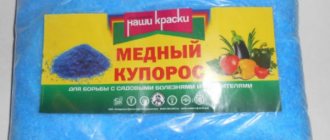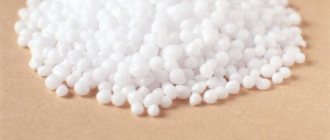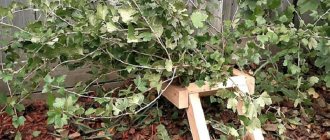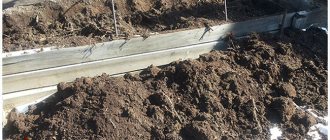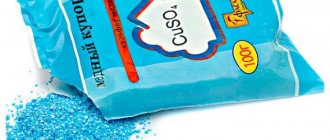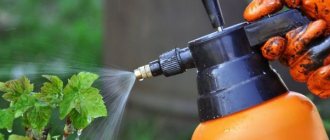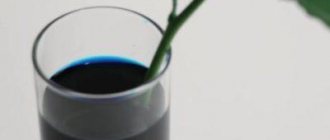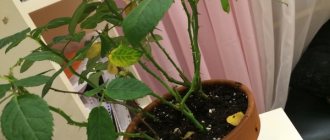Main characteristics and purpose
Iron plays a role in oxidative and energy metabolism, ensures the formation of chlorophyll in plants and takes part in the respiration process. Iron sulfate is recommended for use in the following soils:
- salted;
- carbonate;
- with acidity more than 7;
- calcined;
- with a high content of magnesium and phosphorus.
Copper sulfate is the only source of iron in high concentrations, which is well absorbed by the root system of roses. In gardening, 53% sulfate is used, which has the form of a green powder. The drug has a wide range of capabilities and is often used to provide additional nutrition.
Attention! Treatment of roses with iron sulfate in the fall is carried out to prevent fungal infections after insulating the bushes for the winter.
The list of indications for use includes:
- prevention of fungal infections by irrigating the soil and above-ground parts of crops;
- treatment of fungal infections;
- prevention and treatment of non-infectious chlorosis;
- treatment of land and plants to prevent the vital activity of pests and larvae;
- disinfection of cracks and damage to the bark.
Treating roses in autumn with a solution of ferrous sulfate prevents the development of root rot and other damage to the plant over the winter. Spraying and processing of roses should be carried out in accordance with the proportions recommended for the crop. The use of concentrated formulations can lead to the cessation of growth and development of the root system for an indefinite period of time.
What can you mix iron sulfate with?
The drug is characterized by high acidity (pH 3.5), so it is not combined with substances that give an alkaline reaction: calcium, zinc, boron, magnesium, copper. In addition, simultaneous use with lime (which is often practiced for copper sulfate), insecticides and other chemicals is not allowed. Such mixtures will not bring any effect, and may, on the contrary, harm the plants.
Related article:
Gardening wisdom for organizing garden work
To improve the adhesion of the ferrous sulfate solution to the surfaces being treated, you can add laundry soap to it, which should be accompanied by a neutral reaction.
Iron sulfate as one of the ways to care for roses
Roses, although perennial plants, can die even after a not very cold winter with insufficient attention and improper care. To prevent this from happening, the bushes need to be well prepared for wintering - treated with appropriate preparations, pruned and covered . Only then can you be sure that in the spring the bush will begin to develop and bloom with renewed vigor.
inkstone
Currently, there is a great variety of fungicides, antiseptics, and fertilizers that at the same time nourish and protect plants from diseases. But, despite this, many experienced gardeners and flower growers still prefer the old proven remedy - iron sulfate. Autumn spraying of garden crops and perennial shrubs, including roses, with a solution of iron sulfate has a very beneficial effect on them:
- effectively fights dangerous fungal infections such as powdery mildew, gray mold, black spot, anthracnil, coccomycosis ;
- saturates the soil with a macroelement - iron, which helps rid roses of chlorosis, active growth of green mass of plants, the growth of new young shoots, and the formation of a large number of buds
Beginning gardeners often confuse copper sulfate with iron sulfate. You need to know that these products are completely different in composition, and, therefore, their principles of action and purpose are also different.
Characteristics of the product
Ferrous sulfate (FeSO4), popularly known as iron sulfate, is a crystalline substance (salt) formed by the interaction of two-phase iron with sulfuric acid at a concentration of 53%. Available as a granular, free-flowing powder of bluish-green, sometimes greyish, color, easily soluble in water. The drug is hygroscopic, so it is recommended to store it in a dry place in a tightly closed container; under these conditions, its shelf life is unlimited.
Of all the fungicides used in horticulture, iron sulfate is considered the least toxic to plants. Moreover, being a natural macronutrient, it is simply necessary in some soils lacking iron.
Sulfur is also not only a fungicide, but also a microelement necessary for normal plant growth. What is not an argument in favor of the advantage of the drug over other similar drugs?
As for the effect of iron sulfate on plants and soil, it should be noted that this is a contact fungicide, it does not penetrate plant cells, and is washed off quite quickly and easily with water. It is safe for humans even during processing. Of course, you should not neglect protective measures (gloves, mask), but if a drop of the product does get on the skin, nothing bad will happen, including a burn. Simply rinse your skin with cold water and not worry about the consequences.
Beginning gardeners often confuse copper sulfate with iron sulfate. You need to know that these products are completely different in composition, and, therefore, their principles of action and purpose are also different. Iron sulfate is more effective in terms of potency, but its scope of application in gardening is not so wide. For example, it is not recommended to spray vegetables (tomatoes, peppers, potatoes, etc.) or indoor flowers with iron sulfate, but use it only for the garden.
Purposes of application
The scope of application of copper sulfate is extensive. It is widely used in industry and medicine. In amateur gardening, it is often used as a fungicidal agent, providing protection against the development and prevention of fungal diseases. Some sources contain information that a low concentration working solution of iron can be used as a fertilizer. After watering, rapid growth of above-ground leaf mass is observed. Frequent use in high doses is dangerous for beautifully flowering plants due to the lack of flowering. Concentrated solutions can damage the root system and cause leaf burns, so roses must be handled carefully.
Stimulation of plant growth appears some time after treatment, so this effect should be associated with the overall health of the rose bush. Immediately after using vitriol, the leaves of the plant may turn yellow and fall off. Treatment in spring leads to a slight deviation of the vegetation cycle - 1-2 weeks from the norm.
When feeding garden roses with copper sulfate in the fall, you need to remember that in addition to iron, the plant needs other microelements and nutritional components, so it is better to use complex formulations, and use copper sulfate for treatment against fungus and pests.
The solution is used in the fight against the following diseases:
- mycoses;
- powdery mildew;
- gray rot;
- black spot;
- anthracnose
Gardeners recommend watering the rose garden with a weakly concentrated solution before sending the plants for the winter. The soil contains spores of various fungi and other pathogens, which can become active after the shelter is constructed.
Category “Questions and Answers”
For autumn treatment of roses, it is better to use broad-spectrum protective agents.
Question No. 1. Is it better to spray roses with chemical fungicides or biological products?
For prevention, biofungicides can be used. But the difficulty is that most of them contain living microorganisms that suppress pathogenic flora. Their effect appears only at positive temperatures; in the cold they are useless. That's why it's best to use them in spring and summer. For autumn treatment of roses, it is better to use chemicals. If this is not possible, for example, due to allergies, then an infusion of ash is used. It is prepared according to this recipe:
- 100 g of ash is poured into 10 liters of warm water, stirred until completely dissolved. Then they filter and spray the bushes and the soil under them.
The result is a triple effect - fertilizing with phosphorus-potassium fertilizers, preventing diseases, neutralizing soil acidity.
Question No. 2. Why pick off the leaves on roses?
Pathogens overwinter on them, so it’s better to get rid of them.
Features of the drug
Treatment of roses with vitriol can only be carried out in the fall. Using the drug in spring is dangerous for the plant because it provokes the formation of brown spots on the leaves. They do not harm the bush itself, but the leaves cannot be restored. Autumn treatment is carried out after falling or preliminary removal of green mass. Before wintering, you need to treat the bush for preventive purposes with a solution of 3% concentration, that is, dissolving 30 g of the drug in 1 liter of water. High concentrations can cause burns to young shoots of shrubs, and low concentrations are not effective in combating mycoses.
In emergency cases, solutions with a concentration of 1% can be used after the leaves and buds of the rose bloom. The buds must be protected from liquid, the solution is carefully distributed over the leaves using a spray bottle. Treatment is carried out at intervals of 10 days, twice. The activity of the product decreases after rain because the product is washed off the leaves.
When preparing a rose garden for winter, you need to remember that covering the flowers until they dry is prohibited. The solution needs 2 days to work, without precipitation. Fallen leaves must be removed and burned. It is not allowed to use vitriol in a mixture with other fungicides or lime.
Advantages and disadvantages
Like any fungicide, ferrous sulfate has not only pros and cons in its application. The positive qualities of the drug include the following:
- profitability - the drug is one of the cheapest in terms of cost;
- high efficiency in suppressing fungal flora;
- minimum level of toxicity for people, plants and soil;
- contact effect - the drug acts only externally, without penetrating into plant cells.
The disadvantages of the drug include the following:
- low effectiveness against pests is rather a fact and not a minus, since the drug is a fungicide and not an insecticide;
- limited period of use: before buds open, or after leaves fall;
- negative, or more accurately, aggressive effect on green shoots and leaves;
- Difficulty in dilution - a 3% solution is considered effective for treating roses, but in such a concentration the product leads to burns, while a 1% solution does not harm the leaves, but does not have the desired effect;
- easily washed off - after rain the effectiveness of the drug is zero and repeated, sometimes multiple spraying is required;
- Ferrous sulfate quickly loses its fungicidal properties due to oxidation - the period of protective action of the drug lasts no more than 14 days.
The product also has one property that can be called both positive and negative. Spraying plants with iron sulfate slows down the awakening of plant buds, which, in conditions of sudden temperature changes, allows you to adjust the vegetative process depending on the weather.
Current questions about the use of iron sulfate
Question No. 1. A few days after treatment with iron sulfate, the shoots and leaves of the rose under the cover turned black. What to do?
Wait for spring. The beginning of the growing season will indicate whether the blackening is caused by a chemical burn as a result of exceeding the concentration of the drug. If the shoots die, they will have to be cut back to healthy tissue. However, sometimes black spots after treatment with iron sulfate are not a sign of a burn. The drug can color insufficiently matured or unhealthy areas of the shoots. And blackening of leaves is a common occurrence. Iron sulfate is aggressive towards soft tissues. They will need to be removed in the spring.
Advantages and disadvantages
The antifungal agent has advantages:
- low price;
- high damaging ability against fungi;
- non-toxic to humans;
- does not change the qualities of the soil mixture;
- stimulates crop growth and increases immunity to diseases;
- acts externally and does not penetrate cells.
Disadvantages of the product:
- low efficiency as an insecticide;
- restrictions on the period of use (before bud break and after leaf fall);
- destruction of the green mass of the plant;
- difficult to choose concentrations;
- It is washed off after precipitation and stops working.
Attention! Iron sulfate is declared as a fungicide, but is actively used to kill pests.
Features of the use of fungicide, its pros and cons
To start using the product, you need to know exactly for what purpose it is used and what iron sulfate is.
Iron sulfate is a salt, a compound of iron and sulfur (FeSO4), containing two necessary components. Salt is hygroscopic (it should be stored in a tightly sealed container in a dry place) and easily dissolves in water. Like iron, sulfur is also necessary for the full growth and nutrition of plants: it ensures important biological processes, in particular, sulfur has a beneficial effect on the absorption of nitrogen, which ensures normal growth and development of all types of plants.
The cause of chlorosis in roses is a lack of iron.
If your roses are stunted, the leaves are yellowish and small, it means they probably lack sulfur. Iron starvation also has a negative effect on roses; the leaves begin to become covered with yellow spots, which indicates chlorosis. Many soil compositions are usually poor in these elements, so treatment with iron sulfate is very effective.
One of the main positive qualities of iron sulfate is its non-toxicity.
It has only a contact effect, without penetrating the plant cells, and is easily washed off with water. This is both an advantage and a disadvantage - the treatment should be carried out in dry weather and in such a way that the branches and the ground around have time to dry before the rains. Only then can they be carefully covered with film; wet roses cannot be covered.
Advantages of the drug:
- maximum effectiveness against fungal infections ;
- profitability - compared to other drugs with similar effects, the price is very low;
- safety , low toxicity;
- contact action .
Of all the fungicides used in gardening, iron sulfate is considered the least toxic to plants
. Disadvantages:
- limited periods of use ;
- harmful effects on the green mass of plants;
- quickly loses its protective properties (effective for up to 2 weeks, then the iron is completely oxidized and the drug loses its fungicidal properties).
Treatment of roses in autumn
The rose garden can be affected by fungal diseases. To prevent and combat diseases, the rose garden is treated with folk remedies or fungicides in the fall. Let's talk about common problems and how to treat them.
Severe damage to black spot leads to the death of the rose. Photo: dacha.help
Purchased funds
For powdery mildew and black spot, antifungal agents are used: Topaz, Rayok, Skor, Bayleton. These drugs work more effectively in alternation with Profit, Ridomil, Quadris. It will be necessary to carry out 3-4 treatments at intervals of 7 days. For severe lesions, Oxy-Khom, Topsin, Khom are used. Treat 2-3 times, every 7 days.
At the first signs of rust , Strobi and Topsin help. If rust has infected a bush, it is impossible to cure it - it is dug up and removed from the site.
Rust is easy to detect - bright orange pads form on the buds and leaves. Photo: dacha.help
For prevention, healthy bushes are sprayed with Fitosporin. You can start in mid-August: 2–3 times, with an interval of 7–10 days. The work takes place in dry weather, the sheet is wetted on both sides.
An indispensable means for prevention is Fitosporin. Photo: dacha.help
Disinfects and feeds Calimagnesium in granules. The substance is introduced into the tree trunk circle in front of the shelter (October-November). Burgundy and Bordeaux liquids work well.
Signs of chlorosis are a pale leaf with dark green veins. Adding iron sulfate to the soil helps preserve the bush. The powder is scattered on the ground before covering for the winter. The second method is spraying with iron sulfate. To do this, you need to make a 3% solution: 300 g per bucket (9 l).
An unbalanced soil composition leads to chlorosis (lack of iron). Photo: dacha.help
A universal remedy is Hom. The drug treats and protects against the occurrence of infectious and fungal problems. Iron sulfate burns out spores and mushrooms.
Folk remedies
It is not possible to cure a rose from fungi using folk remedies. But for prevention or for partial damage, the remedies are effective.
Method 1. An antifungal recipe is created based on wood ash. For 10 liters, 1 kg of ash is used, infused for 2 days. Add 1 tbsp to the strained mixture. l. crushed soap. Spraying, with complete wetting of the foliage, is done 2-3 times with a week break.
Method 2 . Onion peels help against pests and diseases. In 10 liters, 200 g of husk is infused for 8 hours. Treatment is done every 5 days 2-3 times.
Method 3. For powdery mildew, use soda ash: 1 liter of water + 2 tsp. + 1 tbsp. l. liquid soap. 2 sprayings are carried out at weekly intervals.
Method 4. Rust, in the initial stage, completely disappears when using milkweed. An infusion is made from the chopped plant: 1.5 kg + 10 liters of water. After 24 hours, the solution is ready; just 2 sprays are enough.
How to dilute the drug
To dilute iron sulfate for treating plants, you need glass, ceramic or plastic containers without residues of other substances. The procedure will be as follows:
- Slowly pour the drug into warm water.
- Stir with a wooden spatula.
- Let it brew for 15-20 minutes.
- Stir again and make sure there is no sediment. Strain if necessary.
The amount of iron sulfate is selected depending on the purpose of use and the type of crops being processed (more about them below). For example, to make a 3% solution, you need 300 g of the drug per 10 liters of water. To obtain a 1% concentration, you need 100 g, 5% - 500 g of the substance.
Related article:
Preparing the garden for winter and the future harvest: 6 mandatory things to do in the garden in the fall
When there are no scales, the required amount of iron sulfate will help you measure out a matchbox that holds 22 g, a tablespoon - 16 g, a teaspoon - 5 g.
Preparation of working solution
To effectively combat fungal infections, rose bushes are treated with a 3% solution. You need to spray the bush thoroughly. The manipulation is carried out on dry days, because the solution must dry on the leaves. If it rains, you need to repeat the treatment.
If the treatment was not carried out in the autumn, it is carried out in the spring. For this I use a 1% solution. To prepare a working solution with a concentration of 3%, dissolve 30 grams in 10 liters of water. drug, to obtain 1% - 10 g. The dry mixture is poured into cold, clean water and the mixture is vigorously stirred until completely dissolved. Do not use the product together with other fungicides. The finished composition is used immediately; upon contact with air, it loses its activity.
You may be interested in:
Vitriol for treating the garden in the fall against pests and diseases To prepare trees for winter, experts advise timely treatment of the garden in the fall against pests and...Read more...
Features of working with the solution
Experienced gardeners recommend treating with a fungicide after the leaves fall. If the plant was not sprayed in the fall, this should be done in the spring, but before growth begins. The purposes for using the product are different, as are the methods of application. A solution of vitriol is used to spill the soil and spray the above-ground part.
For fungal infection
Fungal infections often get into the rose garden with new, acquired varieties, so before planting new bushes in the garden, they need to be inspected for the presence of fungi and pests.
The list of common fungal infections of roses includes:
- spheroteka;
- peronosporosis;
- gray rot;
- rust;
- infectious burn;
- septoria.
Iron sulfate is used for the prevention and treatment of these diseases in seedlings. Use a 3% solution, which is applied to the shoots using a sprayer. The leaf mass will be lost. The period of operation of the product is 2 weeks.
Insect control
To treat pests, the working solution is used in the fall, before covering the rose garden for the winter. Before irrigating the above-ground part of the plant, sanitary pruning is carried out and all fallen leaves and removed stems are removed from the front garden. Before spraying, you need to water the soil and feed the rose before wintering.
Additional food
Treating a rose garden with vitriol in the fall can be done not only for the purpose of healing, but also for fertilization. To do this, dissolve 30 g of the composition in 3 liters of soft water. The drug is used at the rate of 10 liters of working solution per 100 square meters. Watering is carried out in dry, windless weather. This technique is not used in summer.
Caring for the rose garden in October
The features of this stage are as follows:
- We stop loosening the soil under the roses to slow down the access of oxygen to the roots;
- Stop watering roses and fertilizing them;
- If October is rainy, then the rose garden needs to be covered with film and water should be drained from the roots;
- At this stage, disease prevention is mandatory - spraying and cleaning the bushes.
You need to follow these steps:
- Spraying bushes with 1% Bordeaux mixture. This will rid the stems of bacteria and pests;
- Tear off all the foliage and bend the unripe buds. There is no need to trim the buds yet; this may trigger the release of new inflorescences, especially if October is warm;
- We trim the roses. Shrub, miniature and heat-loving roses should be shortened to the height of insulation. Climbing and standard varieties need to be pinched at the growth point, removed from the support and laid on the ground;
- We replant roses that did not grow well this season, or plant new varieties for the rose garden.
How to treat the above-ground part and soil
Treatment should be carried out by spraying in the fall, but since rose disease occurs regardless of the season, iron sulfate is used in small concentrations during the growing season.
Treatment of shoots in spring and summer is carried out according to the following scheme:
- use a solution with a concentration of 1%;
- it is distributed over the leaves and shoots of the plant using a spray bottle;
- rose flowers are removed before processing;
- fallen leaves are collected and burned;
- The treatment is repeated 3 times every 10 days.
Treatment scheme in autumn:
- carry out autumn pruning;
- remove fallen leaves;
- prepare a solution of 3% concentration and spray the rose with it;
- You can cover the bush on the 3rd day after the manipulation, but no later than on the 14th day.
Attention! After treating with a fungicide, the bush is covered for the winter immediately after the composition has dried to prevent re-infection.
You can water the soil with vitriol before wintering the plant, because fungal spores can form from the soil. Be sure to spill the prepared mulch with the mixture.
Basic rules for processing rose gardens in spring and autumn
Treatment of rose bushes should be carried out exclusively in the fall, preferably after leaf fall. If there are still leaves on the bushes, it doesn’t matter, the vitriol will speed up the process of falling leaves. If autumn treatment has not been carried out, you can spray the roses in the spring, but always before the beginning of the growing season (bud swelling). This is due to the fact that the optimal concentration of the solution that destroys fungi and prevents their appearance is 3% (300 g of iron sulfate per 10 liters of water). But a solution of such a concentration has an aggressive effect on young green shoots and leaves, leaving burns on them, so the treatment time with the drug is limited.
It is best to treat roses with iron sulfate solution in the fall.
In case of rose disease with black spot or chlorosis, you can treat with a 1% solution directly on the green leaves, 3-4 times with an interval of 7-10 days (taking into account weather conditions).
Before processing rose gardens, all fallen leaves must be collected and burned, as they are a breeding ground for fungal spores. Spraying is carried out in dry, windless weather, completely covering all branches, shoots and soil around the bushes with the solution. Since iron sulfate is very easily washed off with water, the weather for processing must be chosen that is not rainy. The preparation must have time to dry on the roses, only after that you can start wrapping them with film.
What to feed roses in the fall?
Fertilizing can be carried out in three ways: dry fertilizer composition poured under the root; liquid fertilizer for irrigation; liquid fertilizer for spraying the above-ground part of the bush.
I. Fertilizer for irrigation
A tablespoon of potassium sulfate, 2 tablespoons of phosphate and half a teaspoon of boric acid are added to a bucket of water. You can water roses with this solution 2 times in the fall - at the beginning and end of September, and in cold regions - at the end of August and beginning of September.
II. Spray composition
For 30 liters of water you need to take a tablespoon of potassium monophosphate and superphosphate. The bush should be irrigated with this solution every 3-4 weeks until mid-October.
III. Dry feeding
There are two folk remedies that gardeners use today for flowers and garden crops in the fall. These are wood ash (sources of phosphorus and potassium) and grated banana peel. The ash is diluted in water or sprinkled with dry powder on the ground. Banana peels are crushed dry and dug into the soil under the roses. You can bury fresh banana peels under the roots, but this should only be done in early autumn so that the fertilizer has time to rot.
Such products can be combined, but the main thing to remember is that the last feeding should be done no later than the beginning of October (or mid-September in cold climates). The last means of nutrition, and at the same time disinfection, is potassium magnesia in granules. It can be scattered over the surface of the soil before covering the roses in October or November.
Transplanting rose bushes
September-early October is the best time to replant roses. The first in line to change their place of residence should be weak roses that have responded poorly to care throughout the entire growth period. For new residents of your rose garden, it is also better to find suitable places in the fall:
The process of transplanting roses is as follows:
- Choosing a sunny, open place for flowers;
- Marking and preparing holes for planting. Miniature roses can be planted thicker (40-50 cm between bushes), climbing and bush varieties require sparse plantings - 1-1.5 meters. The standard size of the holes is 50x50 cm;
- Preparation of nutrient soil mixture. Peat, sand and compost are taken in equal proportions. The soil for roses can be diluted with clay. Ash, bone meal and other nutritional components are added to the finished mixture;
- Planting seedlings. Pre-soaked seedlings are lowered into the holes with their roots, the roots need to be straightened. The bush is covered with earth and watered thoroughly. When the water is absorbed, the young roses need to be spudded.
Comparison with other fungicides
The comparative table shows popular analogues of vitriol:
| A drug | Description |
| Ridomil gold | A product that is safe for roses and not only has a contact effect, but also penetrates the stem. The product is not washed off after rain, therefore it is more effective than kuparos due to its long-lasting action. |
| Oksikhom | Used to treat rose gardens against mycoses at any time of the year. There are no strict contraindications for use during the flowering period. |
| Abiga peak | It is washed off with water, so it stops working after rain. Does not harm green mass. |
| Bordeaux mixture | Widely used in gardening, but preparing a working mixture is difficult. |
Attention! The development of new, more effective means is constantly underway, so there is no point in abandoning their use in favor of the usual vitriol. Such products are adapted to the needs of the plant and cause less harm to it.
What is copper sulfate
A water-soluble, colorless, odorless chemical substance, copper sulfate, has disinfectant properties, is widely used in medicine as an antiseptic, and in plant growing as a fungicide. Effectively fights fungal diseases of fruit trees and rose bushes. The traditional name is copper sulfate. When interacting with enzymes of fungi and bacteria, it causes irreversible changes in the latter.
Application in horticulture
Copper sulfate is used in the garden in the fall to protect fruit trees, shrubs, flowers and soil from a number of diseases caused by the activity of microorganisms and insects. Experienced gardeners recommend autumn spraying with a solution of the drug for preventive purposes and to destroy colonies already existing on plants:
- fungus;
- scab;
- powdery mildew;
- rust;
- late blight.
Plants growing in acidic sandy or peaty soils receive too little copper. They experience insufficient growth, wilting of leaves, and with a severe lack of copper, ears and seeds do not form. In this case, treating the soil with copper sulfate in the fall is a fertilizing procedure. If a fungicide was used as a fertilizer in spring or summer, there is a risk of oversaturation of the soil with copper.
Antifungal protection for roses in spring
In spring, copper sulfate (copper sulfate, CuSO4) is more often used to combat pathogenic fungi. When dry, it appears as small, bright blue crystals. Copper sulfate has pronounced antiseptic and fungicidal properties. It also fertilizes the soil, positively influencing plants and stabilizing metabolic processes.
The advantages and disadvantages of copper sulfate differ little from its “iron” counterpart. It is low-toxic, cheap, easy to use and prevents the development of pathogenic microflora, especially powdery mildew or septoria fungus. Treatment of roses with copper sulfate in the spring is carried out in the “green cone phase,” that is, immediately before the buds open. The average air temperature is about 5ºС.
The rules are the same as when working with iron sulfate: only in dry weather with the “capture” of soil and mulch. Spraying with copper sulfate is carried out for preventive purposes; it will not cure already infected plants. To treat rose bushes, choose the second half of the day, towards the evening, then tender young shoots and hatching leaves will not receive a thermal burn.
To treat blooming greenery and flowers, they do not use pure copper sulfate, but a mixture of it with milk of lime. The fungicide is called "Bordeaux mixture".
How to make a working solution of copper sulfate
It is recommended to prepare a 10% master composition in advance, which is then stored in a dark place (up to 1 year) and diluted as needed. Copper crystals are dissolved in warm water to make the process go faster and the liquid to be homogeneous. The working solution is made immediately before use in a glass container.
The optimal concentration of copper sulfate is 1%. If the rose garden was previously infected with a fungus - 2%, but no more. Having prepared the solution, use it immediately, after filtering the sediment.
Recipe for 1% Bordeaux mixture:
Mix 100 g of copper sulfate with 150 g of slaked lime. Dilute 10 liters of clean well water at room temperature. There is no point in storing the learned fungicide; it will lose its disinfecting properties.
Warning: Spraying with copper or iron preparations is carried out wearing rubber gloves and a respirator; it is better to protect your eyes with special glasses.
Rules for preparing roses for winter
Autumn events are held regardless of the climate, the differences lie in the timing. The table shows the approximate work time in different climatic zones.
| Region | Events, timings |
| Central Russia, Moscow region | Feeding - late August, early September Pruning - mid, end of September Creating a shelter - third ten days of October |
| Leningrad region | Feeding – mid-August Shortening shoots - September Warming the first ten days of October |
| Southern regions | Fertilizer application - during September. Haircut – October. No cover required. Hilling is carried out, sprinkling the tree trunk circle with sawdust and fallen leaves |
| Siberia, Ural | Fertilizer application - early August Pruning - end of August Shelter - end of September |
If fertilizers have been applied, disease treatment has been carried out, shoots, buds, and leaves have been pruned, then the last stage of preparing the rose for winter begins—sheltering. You will need thick gloves, material for tying and covering the bush, stones (metal pins) for fixing the branches.
Tall bushes need to be tied with garden rope, strong cord or wire. Many people use old tights; they are elastic, soft, and do not damage the bark. Climbing and tall garden roses are laid on the ground.
Thick trunks are bent very carefully, in several steps, with an interval of 3–5 days. When the ends of the branches are on the ground, you need to pin them with wire/arcs or press them with a cobblestone/brick.
The ground around the bush is insulated with peat or dry leaves and sawdust. After this, the bush is covered with any available material: lutrasil, thick non-woven fabric, agrotex, spruce branches.
The covering is laid on branches, a frame made of arches, on a structure made of boards and boxes. Photo: sornyakov.net
Do not cover with film, roofing felt or other “non-breathable” materials. Without air access, at positive temperatures, damping occurs.
Chemical protection products for the prevention of rose diseases
Iron sulfate or copper sulfate is used as a prophylactic against plant diseases and pests.
Many gardeners try to choose disease-resistant roses, but even they should be protected from possible diseases. Even if your site is perfectly groomed, danger may come from a neighboring garden or from wild plants. That's why you shouldn't rely on chance and treat roses for infection. Especially if obvious symptoms of the disease are identified. Spraying with fungicides in the fall will prevent pathogens from surviving until spring. This way you can avoid its spread.
For this purpose, both long-tested and modern drugs are used.
One of the most famous substances for autumn treatment of roses is iron sulfate . For autumn spraying of roses, prepare a solution of 300 g of the substance and 10 liters of water (3% solution). The treatment is carried out after complete dissolution of the crystals (
Treating roses with vitriol to prevent fungal infections
A well-groomed rose garden is the main decoration of any garden plot. But the “queen of flowers” is gentle, vulnerable and capricious, as befits a royal person. It has many natural enemies, among which the most dangerous are fungal infections that can destroy more than one plant in a short time. Prevention here is many times more effective than combating a widespread disease, since it is difficult to identify all its foci. One of the most effective measures is the treatment of roses with iron sulfate in the fall, before covering for the winter.
The fungicide will prevent the proliferation of fungal spores that form in a humid environment under fallen leaves or polyethylene that protects flowers from the cold. In addition, the chemical compound contains a useful element - sulfur, which is necessary for plants during the dormant period and when leaving it. In the spring, when the protective winter covering is removed, rose bushes should be additionally sprayed with copper sulfate, then they will be reliably protected from fungus and will be able to delight with a healthy appearance, as well as lush, long-lasting flowering.
Spraying with copper sulfate in autumn
When asked whether it is necessary to treat the garden with copper sulfate in the fall, gardening manuals answer in the affirmative. On the eve of cold weather, insects hide in the bark of trees, on branches, in the ground next to the roots. Treating the garden with copper sulfate in the fall allows you to destroy single individuals and entire colonies in places where they concentrate in preparation for hibernation. You need to spray the cracks in tree trunks and bark, branches, and the soil next to the plant.
Proportions
Experienced gardeners give precise recommendations on whether it is necessary to treat the garden in the fall with a solution of copper sulfate and how to properly prepare the solution. The working fluid should consist of 100 g of powder and 10 l. water, this amount of solution must be distributed over an area of 100 sq.m. When apple trees are treated, the consumption of the drug is 2 liters per tree. You can soak plant bulbs or tubers in a solution of this consistency before planting. To process apricots and plums, 50 g of copper sulfate per 10 liters of water is required.
Tree processing
Different types of fruit trees and shrubs are sprayed in different ways. The differences lie in the concentration of the drug, time of year, frequency of use, and the rate of consumption per tree or bush. Some diseases require repeated spraying. In some cases, pure copper sulfate is used, in others - as part of a Bordeaux mixture, and sometimes lime is added.
| Disease | Concentration, grams per 10 liters of water | First spraying | Repeated spraying | |
| Quince, apple, pear | Scab, spotting, drying out | 100 | In early spring before the first buds bloom | In autumn, 2 weeks before harvesting the fruits |
| Apricot, plum, cherry | Spotting, leaf curl | 50 | In spring, before the first buds bloom | End of october |
In the fall, rose bushes must be disinfected if exacerbations of fungal diseases have been observed throughout the season. Treating roses increases the immunity of plants and their ability to resist diseases. It should be remembered that fungal spores live both on the branches and on the soil around the bush. Therefore, in order to properly process rose bushes, you must:
- Trim and burn dry branches.
- Remove fallen leaves and loosen the soil around the bush.
- Prepare a 3% solution (dilute 30 g of powder in 1 liter of water).
- Spray the plant at the rate of 1 liter per 1 bush.
Grape processing
Autumn spraying of grapes with the drug is especially effective; it is carried out after the harvest has been fully harvested and the leaves have fallen. Copper sulfate serves not only as protection against fungus, but also as a supplier of a type of iron suitable for plants. A solution of different concentrations is applied to young and old plants. To properly process the grapevine, you should:
- Treat the vine before winter: remove fallen leaves, trim dried branches and shorten living ones.
- Prepare a solution based on the following standards: for a young plant 50 g, for an old plant - 100 g of powder per 10 liters of water.
- Spray the vine at the rate of 1.5 liters per plant.
How to properly prune roses in the garden?
We reveal the secrets of proper pruning of different types of roses.
6. Treat the bushes
In order not to give the fungus a chance, it is advisable to treat bare bushes with iron sulfate or a ready-made fungicide. Fungicides are diluted according to the instructions on the package. Iron sulfate is used in the proportion of 300 g of product per 10 liters of water (3% solution).
7. Spruce up the bush
Make sure the rose grafting site is below ground level. If it is bare, hill up the bush. It is advisable to use ready-made peat soil for these purposes.
However, if in your climate there are frequent thaws in winter and sleet and rain are not uncommon, the rose may begin to rot and rot. Hilling roses in such conditions is possible only if they are planted on a slope and the water near the bush does not stagnate for a long time.
8. Bend down the shoots of climbing roses
For the winter, the stems of climbing roses must be moved to a horizontal position. Even if in recent years they have overwintered vertically, without shelter, you are still taking a risk by leaving them on a support.
If the shoots are thick, there is a chance that they will break. Such plants bend down gradually over several weeks. Every week, lower the shoot lower, fixing it until it touches the ground.
We recommend reading: Becker
Even without further shelter, the likelihood that a rose will overwinter well under the snow is much higher than in the open frost and harsh February sun.
Do not place shoots on bare ground. When the snow melts, the plant may rot. Use wooden boards or a piece of foam as a layer.
9. Take your time with cover
Without additional insulation, roses can withstand temperatures down to -10ºС. Flower growers living in warmer regions cover their roses only in December. As a rule, the most optimal time for covering bushes is the end of November, when the thermometer is set at around 0ºС. The main thing is to catch the moment before a lot of snow falls.
10. Install the arches
Covering roses for the winter means creating a layer of air between the plant and the environment. The larger the air cushion, the more reliable the protection and the lower the risk of the rose rotting. Therefore, it is advisable to install the shelter on arches. Accordingly, it is easier to cover roses growing in group plantings than single plants.
How to treat roses in autumn
Let's get acquainted with the basic rules for treating roses with iron sulfate in the fall.
Deadlines
Spraying a rose garden in autumn usually occurs after the plants have shed their foliage. Until this point, treatment will be ineffective and will not achieve the stated protective goals. However, if the foliage does not fall for a long time, you can spray it on top of it: iron sulfate will contribute to the fall. But the treatment may not be 100% effective.
If for some reason it was not possible to carry out autumn spraying, postpone the procedure until spring. But in this case, it will be necessary to carry out the procedure before the buds on the bush begin to swell.
How to prepare and use the solution
In order for iron sulfate to have the most effective effect on roses, the spraying solution must be prepared immediately before use. Storing the drug is highly undesirable: it significantly reduces the effectiveness of the procedure.
The fact is that ferrous sulfate has a very rapid rate of oxidation. Once the oxidation process is started, it is impossible to stop it. The prepared solution thus quickly becomes useless and even harmful to plants.
The most beneficial concentration of iron sulfate, which is guaranteed to rid roses of most pests and other problems, is 3%. Gardeners measure 300 grams of dry matter and dissolve it in a standard ten-liter bucket of water. We note, however, that such a concentrated solution cannot be used in the spring: it has a negative effect on young greenery. In the fall it is possible and even necessary.
If the bush is sick with chlorosis or spotting, a 1% solution will help: but it must be used until the plant has lost its leaves. And the application should be repeated: at least three times, preferably four.
You can learn more about the features of preparing the solution and its use from the video:
Adviсe
- Before spraying rose bushes in the fall, be sure to rake and remove fallen leaves from the area. We strongly recommend burning the leaves, as they may well contain harmful microorganisms, fungi and larvae.
- Carry out the procedure in dry, windless weather.
- Try to spray the solution so that it completely covers the entire plant. No omissions allowed.
- After the roses have dried, you can begin to cover them for the winter.
- Iron sulfate should not be used together with other anti-fungal medications.
Sources used:
- https://ogorod-bez-hlopot.ru/kak-obrabotat-rozy-zheleznym-kuporosom-osenyu.html
- https://proklumbu.com/otkrutui-grunt/mnogoletniki/rozy/opriskivanie-geleznim-kuporosom.html
- https://rosegardening.org/chem-obrabatyvat-rozu-osenyu-pered-ukrytiem-na-zimu/
- https://plodovie.ru/tsvetnik/obrabotka-roz-zheleznym-kuporosom-osenyu-20867/
- https://qlumba.com/sad/665-uhod-za-rozami-osenyu
- https://small-village.com/rastenija/uxod-za-rozami-osenyu.html
- https://sovets.net/14805-nado-li-obrabatyivat-sad-osenyu-mednyim-kuporosom.html
- https://sornyakov.net/flowers/obrabotka-roz.html
How to protect a rose in winter
Fungal spores, overwintering in shelter, continue to destroy rose bushes, weakening them and sometimes killing them. And with the arrival of spring, the infection “moves” to neighboring plants. To prevent this from happening, before the cold weather, roses are sprayed once with a 3% solution of iron sulfate (FeSO4). Salt is small transparent crystals of a greenish tint. The combination of iron and sulfur has a beneficial effect on the condition of the “queen of flowers,” protecting her not only from pathogenic microorganisms, but also from chlorosis, another scourge of gardeners.
An aqueous solution of FeSO4, the same iron sulfate, is used for spraying only in late autumn, when most of the leaves have already fallen. If it was not possible to treat the flowers before covering, you can do this in early spring, before the buds begin to swell, otherwise burns will remain on the tender young leaves.
Pros and cons of iron sulfate
The availability and low cost of the drug make it one of the most popular fungicides. But the benefits of salt are not limited to this. Among its main advantages:
- Low toxicity. Sulfate is harmless not only to plants, but also to people or pets. Often, factory-made chemicals leave behind an unpleasant odor, killing the natural aroma of roses. With iron sulfate, garden owners will not face such trouble.
- Belongs to the category of contact means. Ferric sulfate acts only on the surface, without penetrating the cell membranes of the plant. It is easily washed off, which can be regarded as both an advantage and a disadvantage - any rain significantly reduces the concentration of the drug on the leaves.
- Creates a film on the stems, protecting them from late frosts and allowing them to go without shelter longer.
- It has insecticidal properties, repelling insect pests, although here it is better to use the drug as an adjuvant.
- “They don’t like” rats and mice, which gnaw at wintering bushes.
However, with all its advantages, iron sulfate is not entirely harmless to roses. It slows down the spring growing season and causes chemical burns of leaves and buds. In addition, its validity period is limited to 14 days. In winter, these “cons” do not matter. But when gardeners decide to process their favorite flowers in the spring, they take a big risk.
If the fungus appears on the bushes during the period of active growth, you need to reduce the concentration of ferrous sulfate in the solution to 1%. Roses will have to be treated three times with an interval of 10 days.
How to use iron sulfide
Since the saline solution is easily washed off with water, it should be applied in dry weather, after making sure that rain is not expected in the coming days. If the unexpected happens and the plants get wet, you will have to repeat spraying the roses and the ground around them when the excess moisture has evaporated. There should also be no wind so that all the concentrate gets on the flowers.
First, fallen leaves are removed from the rose garden - the main refuge for spores of harmful fungi, and they are burned. Unripe shoots and remaining flower stalks are cut off. The bushes are sprayed completely and immediately, without dividing the procedure into several “approaches”. They also treat well-loosened soil around the plantings and winter mulch. After the solution has completely dried, the roses are immediately covered for the winter. Otherwise, the effect of the fungicide will weaken, and the pathogenic microflora will form again.
For mulch and soil, a 5% solution of iron sulfate is needed, especially if the rose garden suffered from fungal infections in the summer.
Preparation of the solution
For a standard 3% mixture, the following proportion is used: 300 g of salt (dry matter) per 10 liters of water. A weaker solution is prepared from 100 g of ferrous sulfate, and a more concentrated one, respectively, from 500 g. You need to mix the ingredients quickly - the salt dissolves well and start spraying without hesitation. Otherwise, iron will react with oxygen and partially lose its antiseptic properties.
It is better to dilute sulfate with rain or well water. Tap water contains salts of heavy metals, which will also not have the best effect on the properties of the fungicide.
